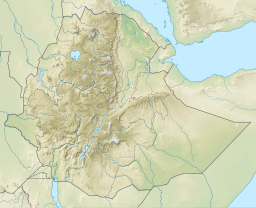| Lake Afrera | |
|---|---|
 | |
| Location | Afar Depression |
| Coordinates | 13°17′N 40°55′E / 13.283°N 40.917°E |
| Basin countries | Eritrea, Ethiopia |
| Surface area | 114.8 km2 (44 sq mi) |
| Average depth | 20.9 m (69 ft) |
| Max. depth | 80 m (260 ft) |
| Water volume | 2.4 km3 (0.58 cu mi) |
| Surface elevation | −112 m (−367 ft) |
| Islands | Franchetti Island |
 | |
Lake Afrera (in Italian Lake Giuletti) is a hypersaline lake in northern Ethiopia. Located in Kilbet Rasu, Afar Region, it is one of the lakes of the Danakil Depression. According to its entry in Lakenet, it has a surface area of 100 km2 (39 sq mi),[1] although another source states the area is 125 km2 (48 sq mi).[2] An unconfirmed report gives its depth as 160 m (525 ft); the lake is fed by underground streams.[2]
It is also known as Lake Giulietti, the name Raimondo Franchetti gave it after the Italian explorer Giuseppe Maria Giulietti was slain by Afars southwest of the lake.[3] Another name for this body of water is Lake Egogi (or Egogi Bad), which is the name L. M. Nesbitt's Afar guide gave it when the Italian explorer became the first European to see it in 1928.[4]
The single island in Lake Afrera, Franchetti Island (also known as "Deset"), located in the southern part of the lake, is considered the lowest-lying island in the world.[5]
Unlike other saline lakes in Ethiopia (e.g., Lakes Abijatta, Shala, and Chitu), the pH of Lake Afrera is low and in the acidic range. Although little studied, a few species of fish are hosted by Lake Afrera, including two endemics: Danakilia franchettii (a cichlid) and Aphaniops stiassnyae (syn. Lebias stiassnyae; a pupfish).[6]
- ^ Lake profile: Afrera ye'ch'ew (accessed 27 April 2007)
- ^ a b Robert Mepham, R. H. Hughes, and J. S. Hughes, A directory of African wetlands, (Cambridge: IUCN, UNEP and WCMC, 1992), p. 168
- ^ Jon Kalb, Adventures in the Bone Trade (New York: Copernicus Books, 2001), p. 72
- ^ Nesbitt, Hell-Hole of Creation: The Exploration of Abyssinian Danakil (New York: Alfred A. Knopf, 1935), p. 337
- ^ Philip Briggs, Ethiopia: The Bradt Travel Guide, 5th edition (Chalfont St Peters: Bradt, 2009), p. 314
- ^ "527: Western Red Sea Drainages" Archived 2011-10-05 at the Wayback Machine, Freshwater ecosystems of the world website (accessed 11 November 2009)
